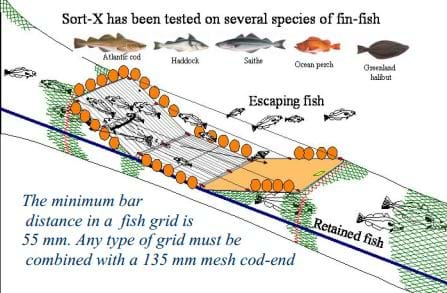Sort X grid
Summary
The Sort X grid was developed in Norway in the early 90's as a measure to reduce the numbers of small fish being caught when targeting cod in the Barents Sea.
This grid works on a different principle to most grids in that it depends on the fish natural escape behaviour and 'co-operation' from individual fish in finding the escape area between the bars. There is some belief that the change in light penetration and water flow between the trawl and grid section help to guide the smaller fish through the grid.

Size selectivity
As with most grids this device is more for size selection than species selection. Being rigid it gives sharp selection of sizes compared to most netting selection devices. The size of fish released can be altered by altering the spacing of the bars.
Other information
Since January 1997 the use of sorting grids has been mandatory in parts of the North East Atlantic, such as the Barents Sea.
During sea trials grid devices are shown to be superior to other selective devices in producing stable and predictable results during changing conditions, i.e. fish densities, time of the year, weather conditions, vessels sizes etc. This is because they are rigid devices with no variation of escape gaps depending on towing speed and conditions.
After the grids became mandatory, many fishermen complained that they were not practical to be used on most fishing vessels. They were big and cumbersome, being approximately 3 metres long and very unwieldy on the deck of a vessel. This is often the case with rigid grids. Therefore several research institutes started to develop their own versions of grids to meet the criticism. A version of the Sort-X made from plastics was tested, but the device never came into practical use.
With the advent of modern plastics and manufacturing processes many more practical designs of grids have been trialled using plastics or composite materials for their construction.
After the Sort-X grid became mandatory, several other grid systems are developed. Today the most frequently used grids are a Norwegian version of the Russian Sort-V device and a flexible plastic grid.
Documents
Selection type
-
- Post-selection